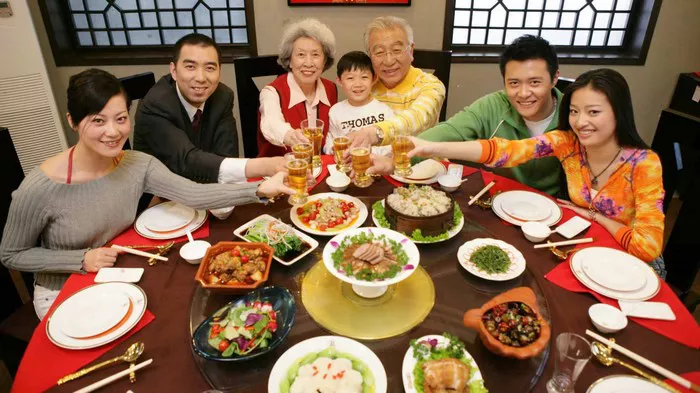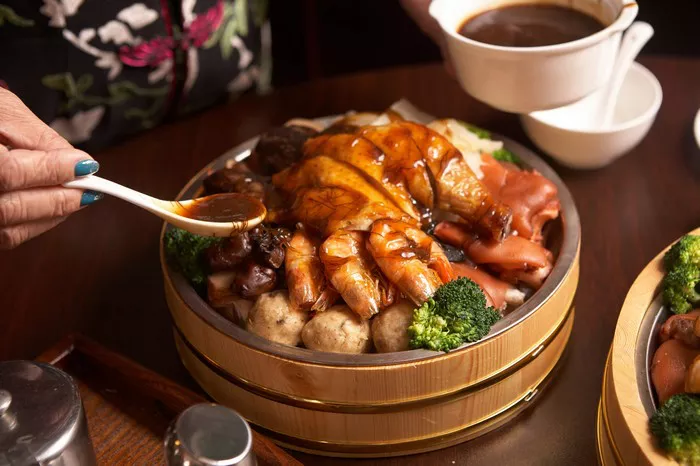The Chinese New Year, also known as the Spring Festival, is a time of vibrant celebrations, rich cultural traditions, and, of course, delicious feasting. This annual event holds immense significance in Chinese culture, marking the beginning of the lunar new year and symbolizing renewal, luck, and prosperity. Central to these festivities is the culinary aspect, as families gather around tables laden with a sumptuous array of dishes that hold special cultural meaning. In this article, we delve into the fascinating world of Chinese New Year cuisine, exploring the traditional delicacies that grace the dining tables during this joyous occasion.
Auspicious Beginnings: Nian Gao and Other Sticky Treats
The New Year’s feast kicks off with a selection of sweet treats that are thought to bring good fortune. Nian gao, a sticky rice cake, is a star of the show. Its name sounds like “年糕” in Mandarin, which is a homophone for “年高,” meaning “higher year” or “prosper year.” This symbolism makes nian gao a must-have dish during Chinese New Year. Made from glutinous rice flour and sweet ingredients such as brown sugar or red bean paste, nian gao can be steamed or pan-fried, resulting in a chewy texture with a hint of sweetness. Families often enjoy these cakes as they believe it will lead to a higher position or achievement in the coming year.
Joining nian gao are other sticky treats like tangyuan, sweet rice balls usually filled with sesame, red bean paste, or peanuts. These round dumplings represent family togetherness and unity. Their round shape is thought to resemble togetherness and unity, reflecting the family’s wish to stay close-knit throughout the year.
Wealth and Prosperity: Tray of Togetherness
A central feature of the Chinese New Year feast is the Tray of Togetherness, a multi-compartmentalized tray filled with a variety of symbolic snacks and fruits. This tray typically consists of eight compartments, as the number eight is considered extremely lucky in Chinese culture due to its phonetic resemblance to the word for “prosperity.”
Each compartment is filled with different offerings, each carrying its own auspicious meaning. Candied melon symbolizes growth and good health, while candied lotus seeds represent fertility and numerous offspring. Candied coconut indicates togetherness, while peanuts signify a long life. These sweet treats are shared with guests and family members as a gesture of well-wishing for the year ahead.
Savory Delights: Dumplings and Spring Rolls
Dumplings, known as jiaozi, are an integral part of the Chinese New Year feast. These savory parcels, typically made with a delicate dough and filled with minced meat and vegetables, are shaped like ancient Chinese currency, symbolizing wealth and prosperity. Families often gather to make dumplings together, fostering a sense of togetherness and unity.
Another beloved dish is the spring roll, also known as “chun juan.” These rolls are filled with various ingredients such as vegetables, meat, and sometimes seafood, then wrapped in thin dough and fried to a crispy perfection. Spring rolls are believed to bring luck due to their resemblance to gold bars, representing wealth and prosperity.
Longevity and Happiness: Noodles and Fish
Noodles hold great significance in Chinese culture and are commonly enjoyed during the New Year celebration. Longevity noodles, as the name suggests, symbolize long life and good fortune. These uncut noodles are typically served in a flavorful broth or stir-fried with vegetables and meat. It’s considered important to not cut or break the noodles, as their length signifies longevity.
Fish, known as yu in Mandarin, is a staple during Chinese New Year feasts. The word for “fish” sounds like the word for “abundance” or “surplus,” making it a symbol of prosperity and good fortune. A whole fish is often served, representing completeness and unity within the family. The tradition of leaving some fish uneaten after the meal signifies surplus for the coming year.
Bringing in Luck: Oranges and Tangerines
Oranges and tangerines are not only refreshing fruits but also important symbols of luck and prosperity during the Chinese New Year celebrations. The Chinese words for orange and tangerine sound like “gold” and “luck,” respectively. These fruits are often exchanged as gifts and placed around the house as decorations to usher in good fortune for the upcoming year.
Sweets for a Sweet Year: Candies and Seeds
In addition to the aforementioned treats, various candies and seeds also play a role in the Chinese New Year festivities. Candies like crystallized fruits and red melon seeds are offered as snacks and gifts. Crystallized fruits represent the sweetness of life, while red melon seeds symbolize happiness and joy.
Modern Twists and Regional Variations
While traditional dishes continue to hold their significance, modern twists and regional variations have added diversity to Chinese New Year feasts. In recent years, fusion dishes that blend traditional flavors with contemporary cooking techniques have gained popularity. Chefs and home cooks alike experiment with new ingredients and presentation styles while still honoring the symbolic meanings behind each dish.
Regional variations also contribute to the culinary tapestry of Chinese New Year celebrations. Different provinces and ethnic groups within China have their own unique customs and dishes. For example, in southern China, tangyuan, or sweet rice balls, are served in a sweet soup with a variety of fillings. In northern China, dumplings are the star, and families compete to make the most creatively shaped dumplings.
Conclusion
As the Chinese New Year approaches, families across the world prepare to celebrate this time-honored occasion with a feast of traditional dishes, each carrying deep-rooted symbolism and cultural significance. From sweet treats that promise a prosperous future to savory delights that represent unity and family togetherness, the Chinese New Year cuisine is a culinary journey through the heart of Chinese culture. Whether enjoying the stickiness of nian gao or savoring the crispiness of spring rolls, each bite is a reminder of the hopes, wishes, and values that make this festival a cherished and vibrant tradition. So, as the lanterns light up and the firecrackers crackle, let us embrace the flavors of Chinese New Year and join in the festivities that celebrate not only a new year but also the rich tapestry of Chinese heritage.























